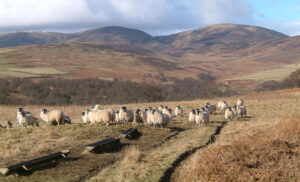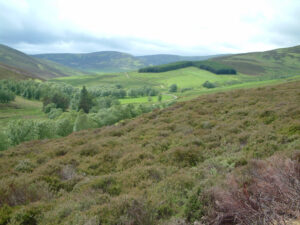What is the challenge farmers and moorland managers face?

Farming/food production is undergoing a period of huge change. Government policy is to move away from directly supporting farmers, to only providing support for delivery of environmental goods and services. All farmers face the loss of the Basic Payment Scheme (BPS), which will reduce to 50% by 2024 and to zero by 2027. We estimate this will mean the farming/land management economy in the PEF area alone (not the whole Peak District) will lose £20m per annum. To replace this, Defra is introducing the ELM. This will be in three tiers:
- Tier 1: the Sustainable Farming Incentive (SFI), which has just opened for applicants.
- Tier 2: Local Nature Recovery (LNR). As yet we do not know very much about LNR but we do know that it will encourage groups of farmers and land managers working together in Farmer Clusters or large groups like this. However, the recently announced five-year roll-over of HLS makes us concerned LNR may not be available for some time. PEF will want to press Defra to proceed rapidly with LNR.
- Tier 3: Landscape Recovery (LR). Defra has just invited submissions for pilot LR projects. LR should offer real opportunity to PEF and we will be working with Defra to make that happen.
It is unclear how much farmers and moorland managers in the Peak District will be able to take advantage of ELM and whether the income and government ambitions will allow their businesses to remain viable. Understanding this financial challenge and bringing it to the attention of policy makers and the PDNPA is one of the key objectives of PEF.
Where will this ‘fair reward’ come from?
We think from four areas:
- Grants and funding for projects. By working together, with strong environmental credentials, and by creating a legal entity, we would be eligible for these grants.
- Creating better opportunity to benefit from the ELM; particularly the Local Nature Recovery tier. We will be asking Defra for this to be support not just for restoration, but maintenance and protection of habitat and species as well.
- New environmental trades, which might be biodiversity net gain and carbon, nutrient reduction, flood mitigation. These ‘rewards’ are probably medium term and require careful scrutiny to ensure we are not ‘selling’ something we might need ourselves (i.e. carbon to offset our own farming operations) or diminishing freehold value due to the long-term nature of some of these arrangements.
- Private funding to support good environmental outcomes, what is called green finance.
What is green finance?
This is private sector finance wishing to invest in good environmental outcomes (green outcomes).
What environmental outcomes might green finance investors be interested in?
- Carbon sequestration and storage in peat
- Wildfire mitigation for precious upland habitat
- SSSI units in favourable condition
- Maintaining and enhancing biodiversity – what could be called managed rewilding
- Flood mitigation
- Water storage
- Clean water
- Clean air
What do the terms “offset” and “credit trading” mean?
What types of environmental trades are there?
At the moment opportunities are developing for:
- Mitigating carbon consumption when fossil fuels are used.
- Offsetting biodiversity loss caused by new houses, roads, industrial premises.
- Phosphate reduction in water.
- Nitrate reduction in water.
How will these environmental trades work?

The aim is that the environmental impact of business and other human activities can be prevented, reduced or offset by equivalent or enhanced gain elsewhere. This sequence of prevention first, then reduction, and finally offset is called the hierarchy.
The offsetting requirement provides business opportunities for those that can enhance the environment they control or manage i.e. those who can provide the environmental gain; farmers and landowners are the sector best placed to do this.
To crystallise this as a business opportunity the environmental loss and the equivalent or greater gain has to be converted to a measurable environmental unit – a credit – which can then acquire an economic value.
The economic value is derived from the market but underpinned on one side by what it costs the landowner to provide the environmental gain (e.g. taking land out of food production to plant trees) and on the other side by what ‘value’ is unlocked for the business by virtue of the off-set (e.g. a developer securing a planning consent, or a water company avoiding the capital cost of a water treatment plant).
How typically would a farmer or land manager get ready to trade in these markets?
Biodiversity baseline auditing
Farmers can only trade a biodiversity gain (an improvement on their current level of biodiversity). NE launched Biodiversity Metric 3.1 in April 2022 to measure existing biodiversity and allow a farmer to calculate how much ‘gain’ could be provided for a trade.
How does one create and measure biodiversity net gain (BNG)?
When landowners, for example, plant a hedge it delivers a BNG. The NE metric converts that into a number of biodiversity credits. A market is being developed whereby those credits can be traded. For example, property developers need to buy credits because the pending Environment Bill will make it an obligation that they provide a 10% net biodiversity gain when they develop land. Some local councils are already asking for 20%. That biodiversity gain should be provided first on-site (i.e. the site of the development itself with landscaping, gardens etc.), second off-site but in the vicinity, then third through government schemes. Once off-site, farms and estates, through a trade, can provide the biodiversity gain.
Brokering legally required BNG trades
We will act as a broker between the supplier of biodiversity credits (the farmers and landowners) and the buyers (the developers who have to buy biodiversity credits to secure planning consent for development), e.g. the Highways Agency or a house builder.
Brokering voluntary biodiversity and other offsetting
We believe we can develop a voluntary market (i.e. not a requirement of the Environment Bill) for BNG, carbon, and possibly nitrate and phosphate offsetting with large corporates, water companies etc. wishing to improve their environmental performance and offset their carbon emissions.
Providing new GWCT carbon credit calculators
Currently there are only two national carbon credit calculators, for peatland and tree planting. Neither is very farmer-friendly. The GWCT has the scientific expertise to create new, potentially more attractive calculators for farmers; hedgerow planting and management, arable conversion to grassland, and so on.
How do we describe the process?
The GWCT has described a series of steps that allows a farmer first to understand his/her farm’s existing Natural Capital, and then to engage in the Natural Capital marketplace.
Step 1
Biodiversity Audit to verify the baseline on Biodiversity Metric 3.1 (BM3.1). This provides a baseline credit quantum.
Step 2
Identify Biodiversity Gain 1 – opportunities for biodiversity gain without taking land out of agriculture – and quantify using BM3.1. Provides tradable credit ‘headroom’.
Step 3
Identify Biodiversity Gain 2 – opportunities for biodiversity gains in place of agriculture. Provides a further ‘funnel’ of tradable credits.
Step 4
Value, then sell or lease biodiversity credits to appropriate parties.
Step 5
Monitor the performance of the biodiversity gain and report on the same to the relevant parties i.e. purchaser, the estate and the Local or County Planning Authority. This will be needed for the ‘term’ of the trade (which might vary, but likely to be 30-35 years).
So, how is this market being formed?
What is is “Natural Capital”?
It is the world’s stocks of natural assets that include geology, soil, air, water and all living things; those assets provided by nature with the capacity to generate goods and services. The benefits provided by Natural Capital (NC) include clean air, food, water, energy, shelter, medicine, and the raw materials used in creating products. It also provides less obvious benefits such as flood defence, climate regulation, pollination and recreation.
The point of NC is that an economic value is ascribed to the provision of these assets; value lies at the heart of the concept. Assessing the value of changes in NC and services it provides is fundamental to deciding how and where funds should be spent to restore, maintain, and manage the natural environment.
How this value and funding will move onto farms in future is not entirely clear, but already being part of Farmer Cluster brings recognition for CSS points and reward for wider landscape impacts, so we expect this trend to continue.
There is a risk that those who have worked hard to create a higher environmental baseline may be less rewarded; this seems perverse, and we will be working with NFU and the GWCT to ask government to change that thinking.
What are the tradable environmental units?
Carbon
These are called carbon credits, quantified by carbon codes. The codes take scientific research on rates of carbon sequestration in say, growing trees, and converts that into a number of carbon credits, which can then be traded, or offset, against a net tonnage of carbon used by a business.
The carbon codes are independently verified so that businesses can be confident they are accurate.
At present there are two carbon codes: Woodland (tree planting) and Peatland Code.
Both are verified by Organic Farmers and Growers. The GWCT is hoping to introduce further codes for hedgerows and arable land reverted to grassland.
Biodiversity

Natural England (NE) has devised a Biodiversity Metric 3.1 which measures ‘everything’ (woodland, hedges, ditches, pollen and nectar mixes, arable crops, ponds) and turns it into biodiversity ‘credits’.
Only ‘gains’ are tradeable. So, it would be difficult to create a biodiversity gain on pristine wildflower chalk downland; whilst converting a wheat field to chalk downland would create a significant gain.
This Code is effectively verified by the government and the 2021 Westminster Environment Bill will require developers to provide 10% net gain on all developments (including government development, e.g., roads, railways etc.).
Phosphate
This seems to be more a matter of negotiation with water companies, local authorities, Environment Agency, etc, but we have identified the metrics used by the Wiltshire and New Forest Planning departments to assess the likely reductions to phosphate levels in the River Avon from changes to agricultural land use (say, from autumn-sown combinable crops to ‘set-aside’).
How can landowners provide the offset?
Carbon – through managing vegetation and soil so that it sequesters more carbon.
Biodiversity – through enhancing habitat, which is the proxy that government is using for biodiversity. As an example, a farmer does not have to provide more lapwing; wet meadows are a proxy for more lapwing.
Phosphate – through reducing phosphate fertiliser application or providing new habitat to reduce soil run-off in a river catchment; both are proxies for deemed improvement in water quality which can permit development.
Nitrogen reduction in water – same principle as phosphates.
Long-term monitoring
Any offsetting contract has to be 30/35 years and there will need to be verification and monitoring that the offsetting is still being provided, and that monitoring will have to be done by a reputable body. The GWCT is in a good position to do this.
Further (very good) reading for the insomniac
The CLA has published an excellent guide to Natural Capital. Find it online here.
